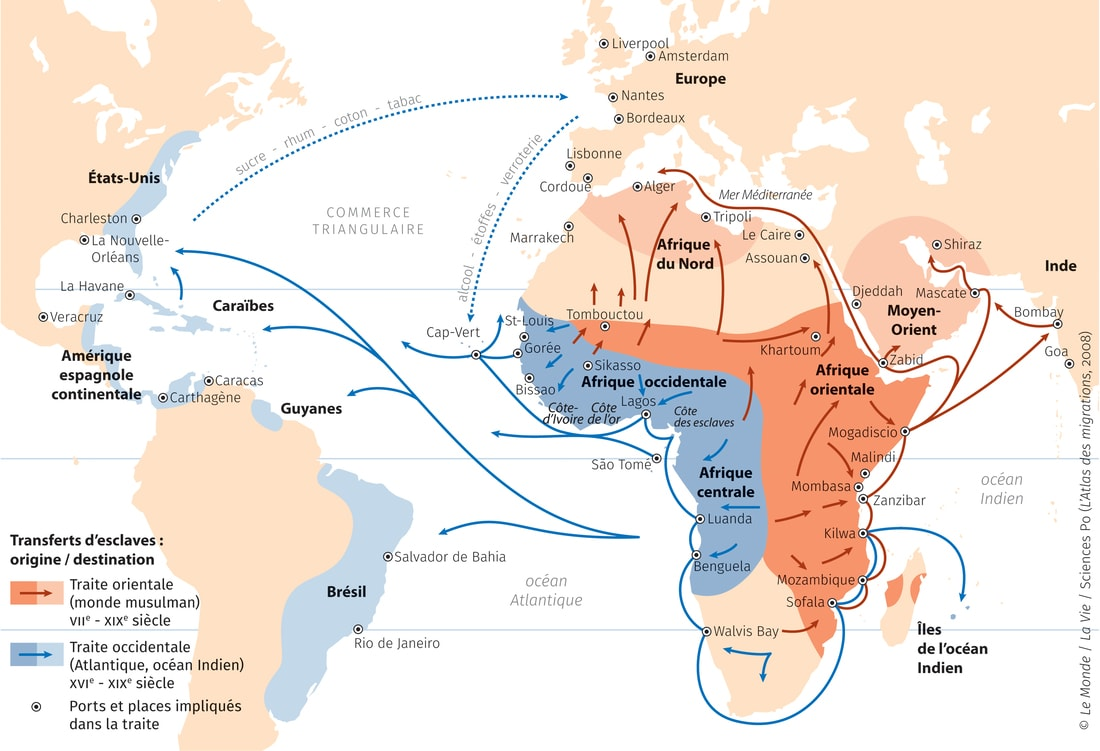The slave trade developed massively with the arrival of the Portuguese, followed by other Europeans, who organized the “Atlantic slave trade,” in addition to the intra-African slave trade that continued to use the caravan routes and the Arab slave trade, which transited through the Mediterranean (towards Europe) and the Indian Ocean (towards the Middle East, India, and Asia). The Atlantic slave trade took the form of the “triangular trade” in the North Atlantic: ships from Europe, loaded with goods (fabrics, weapons, alcohol, etc.), landed on the coasts, exchanged these products for slaves, who were then sold in the Antilles and America. The ships then brought back, in particular, molasses from sugar cane, intended to make sugar and alcohol in European distilleries. In the South Atlantic, it was the “straight trade,” practiced by the Portuguese, that dominated; the ships directly linked the African coasts to the American and Antilles coasts.
It was the Portuguese who established the slave trade in the 15th century. African slaves from Arguin (an island in present-day Mauritania) were sold in the Portuguese city of Lagos in 1444, and the first black slaves were introduced to Hispaniola in 1493. The Portuguese discovered the Cape Verde Islands in 1456 and then those of São Tomé and Príncipe in 1471, which were deserted at the time. They settled there and began to cultivate sugarcane using slaves from the continent. They thus established a plantation economy that was quickly transposed to the American colonies in 1505, and the first triangular circuit was set up, bound for Cibao and Hispaniola. The Portuguese were the first and, for a hundred and fifty years, the only European nation involved in the Atlantic slave trade. The circuits were, from their beginnings in the late 15th century, controlled and organized. The King of Portugal granted exclusive navigation and marketing rights in exchange for royalties.
The Atlantic slave trade accelerated as the exploitation of the American continent by Europeans was accompanied by a strong demand for labor for the plantations of sugarcane, coffee, cocoa, cotton, tobacco, etc., which developed massively in the second half of the 16th century. The demand also extended to the exploitation of silver and gold mines in Peru and Mexico, though to a lesser extent. The Portuguese, and later more broadly, European settlements on the West African coast became the hubs of the slave trade, while within the continent, complex exchange circuits were established, the European Atlantic slave trade combining with the previous circuits that persisted: those of the Eastern slave trade on the east coast and the trans-Saharan slave trade oriented towards the north.
Other European powers became involved in the slave trade in the 16th and 17th centuries, including the French, the English, the Dutch, and even the Danes and Swedes. These European nations followed the same path as Portugal, creating chartered companies (benefiting from a monopoly or privilege granted by a state). However, over time, they were gradually replaced by purely privately run companies; around 1720, the latter dominated the trade, taking advantage of the gradual deregulation granted by European governments. The role of countries in the slave trade fluctuated according to the struggles and balances of power among European nations. The end of the 17th century was marked by French domination, while England dominated the Atlantic slave trade at its peak in the 18th century.
The Europeans had not yet penetrated the interior of the continent. Established on the coast, they traded with coastal ethnic groups and kingdoms that supplied slaves captured inland. African kingdoms, both warriors and traders, prospered thanks to this trade—which coexisted with the oriental slave trade—such as the Kingdom of Dahomey, the kingdom of Kongo, the Ashanti Empire, and the kingdom of Kanem-Bornu, to the detriment in particular of inland Africa, which was the object of incessant raids.
The number of slaves deported from Africa as part of the Atlantic slave trade is estimated to be around twelve million in 400 years.
For more information :
- https://fr.wikipedia.org/wiki/Portail:Afrique
- https://en.wikipedia.org/wiki/Africa
- https://africacenter.org/
- https://journals.openedition.org/etudesafricaines/
- https://etudes-africaines.cnrs.fr/
- https://journals.openedition.org/etudesafricaines/
- https://www.afdb.org/fr/documents-publications/economic-perspectives-en-afrique-2024


